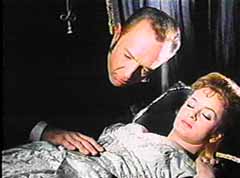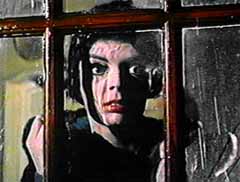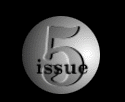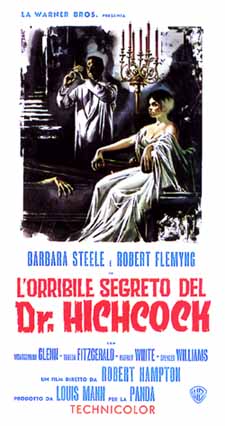|

Dr. Hichcock and his first wife
practice sex games in
The Horrible Dr. Hichcock.
Of all Italian horror from the classic era, 1957-66, Horrible has perhaps the wildest reputation. For all the purported freedom of the screen, horror films unwilling to base their themes in conventionally conservative fantasies today have as hard a time as ever reaching a mass audience. Films with conceptually challenging ideas, such as The Stranglers of Bombay or Peeping Tom, can still be difficult to discuss outside of cult horror circles, even forty years after their release.
Also retaining its power to disturb, the unconventionally aberrant Horrible, is well worth examining, from its peculiar place in the ranks of Italo Horror, to its bizarre, macabre, yet completely reasonable take on sexual relationships.
London, 1885. Dr. Bernard Hichcock is leading a double life. At the clinic, his new anesthetic makes him a surgical miracle man, while at home he indulges nightly in secret macabre love games with his devoted wife Margaretha. In a room draped in funereal black, Hichcock uses his serum to narcotize her into a deathlike state that arouses his passion to delirious levels of intensity. One overzealous night, he injects her with a lethal overdose. She convulses and dies before his horrified eyes.... Twelve years later the Doctor returns from Italy with his new wife Cynthia. Soon she is plagued with nocturnal hauntings: mysterious footsteps, creaking door handles, a skull under her pillow. The housekeeper Marta is hostile, rooms are forbidden, and her husband's aloofness conceal from Cynthia the fact that Hichcock has returned to his old habits....
The central focus of Horrible is the spectacle of the insane Bernard Hichcock (stern-visaged British actor Robert Flemyng) wrestling with, and then embracing, his own demons. He's a perverse hero, one who dares to overstep, undeterred from unspeakable goals. These he pursues with unrepentant delight, largely uncriticized by any moralizing imposed by the filmmakers: this is in no way the sort of "responsible" film that proffers sordid content while pretending to condemn it. What is also atypical is that the actual "corpse-molesting" is represented partly from Hichcock's point of view, with the audience identification techniques commonly associated with Alfred Hitchcock. Unlike the fleeting glimpses of necrophiliac tableau presented in Edgar G. Ulmer's The Black Cat or Roger Corman's The Tomb of Ligeia, here the viewer is allowed an identification with the hero's perverted behavior, an obsession treated as if it were the pinnacle of erotic stimulation. Roman Vlad's swooning violin score signals the onset of Hichcock's unnatural cravings, and shafts of hallucinatory scarlet light erupt whenever he comes close to consummating his "unnatural lust."

Cynthia (Barbara Steele) catches a fleeting
glimpse of Margaretha.
Italian horror in the early 1960's had a unique set of commercial compromises, aesthetic characteristics that are clearly evident in Horrible. Precise camerawork and atmospheric visuals receive a great deal of attention, but more often than not, the actors seem to have been left to fend for themselves. The experienced Flemyng expands his character with a broad range of neurotic behaviors, but the young Barbara Steele tends to rely on mechanical hand wringing to express her nervous state. In one baffling instance, Steele stares vacantly at the camera for a couple of seconds, as if she thought she were performing a run-through and not a final take. Both Ms. Steele and actress Harriet White are on record as having little memory of being given much direction from Italo horror directors Freda, Bava, or Margheriti, who were probably under crushing time constraints just to get scenes shot at all. Writer Ernesto Gastaldi, in his interview with Tim Lucas in Video Watchdog2, explained that Freda was so concerned about the tight shooting schedule that he simply eliminated pages of dialogue scenes that established motivations for the characters. With little character exposition to aid them, viewers must look to subtext to decipher Horrible's disturbing meanings.
It was not uncommon in these Italo horrors to see English-sounding pseudonyms substituted for the real names of the Italian actors and artists. To help get that all-important American sale, they were apparently more than willing to hide behind ersatz English identities, the better to resemble the internationally successful Hammer films. Director Riccardo Freda first used his "Robert Hampton" alias on Caltiki, il mostro immortale (with second-string English actor John Merivale for its lead), a ploy which helped that film get its American release through Allied Artists. For Horrible, anglicized names were used throughout:
- Producers Luigi Carpentieri & Ermanno Donati = Louis Mann
- Director of Photography Rafaelle Masciocchi = Donald Green
- Screenwriter Ernesto Gastaldi = Julyan Perry (often Julian Berry on later films)
- Decorator Franco Fumigalli = Frank Smokecocks
- Actress Maria Teresa Vianello = Teresa Fitzgerald
- Actor Silvano Tranquili = Montgomery Glenn
Multiple titles were employed to court multiple markets. The original Italian release L'orribile segreto del Dott. Hichcock became two variant versions in export: The Terror of Dr. Hichcock (England), and The Horrible Dr. Hichcock (U.S.).3 The two latter versions are available here in the U.S.A.; the American print is about a dozen minutes shorter, and marginally tamer, than the English.4
The absence of explicit nudity, violence, and gore kept the export versions of Horrible from suffering the huge censor cuts that gutted many later European productions. A major part of the frustration/fascination of Italo horror for Yank viewers is looking at Castle of Blood or Nightmare Castle and trying to imagine what additional forbidden content comprised their original versions, Danse macabre (5 minutes longer) or Amanti d'oltretomba (32 minutes longer!). Fortunately, most of The Horrible Dr. Hichcock actually seems to be intact.
Or is it? Unless one can see a rare quality print that retains its original lush photographic presence, Horrible's appeal is greatly diminished.5 Assaying the pale, pan & scanned video cassette versions that have survived the years amounts to an act of faith in the accolades of critics who saw the original on theater screens.
page 1 of 2
 
Italian Horror Menu page
Italian Horror: A Brief Introduction
Mario Bava: The Illusion of Reality
Mario Bava's Rabid Dogs
Mario Bava Biography
The Horrible Dr. Hichcock
The Devil's Commandment 
Castle of Blood 
Nightmare Castle
The Bloody Pit of Horror 
Italian Horror in the Seventies
Suspiria
Italian Horror Web Links
© 1997 Glenn Erickson
Photo credits: Dean Harris, Silent Scream, and Sinister Cinema
|





